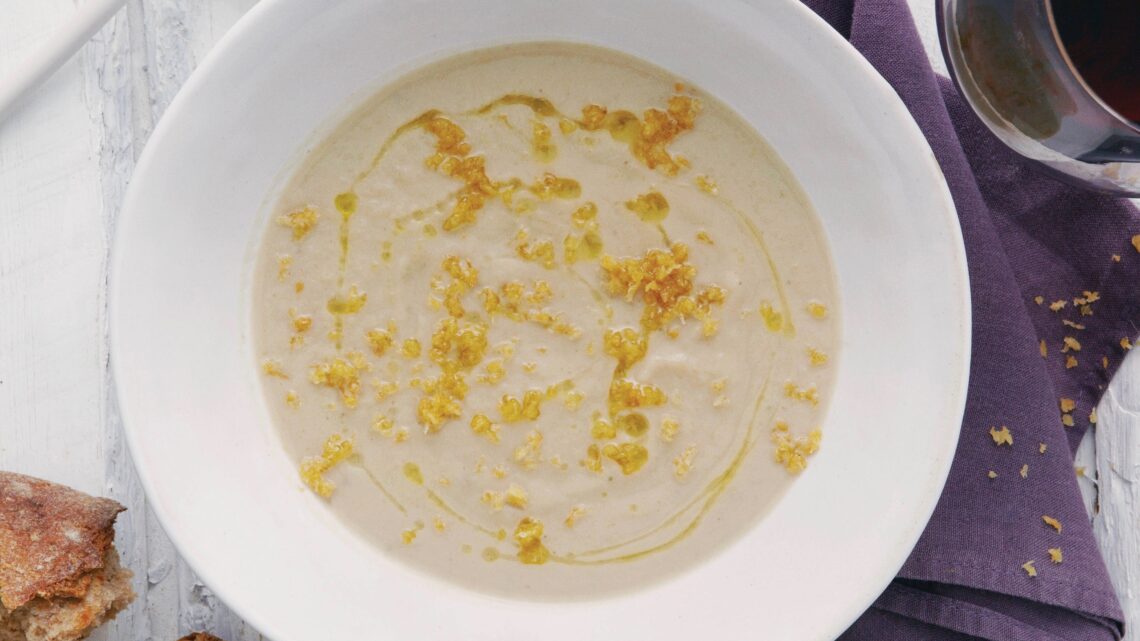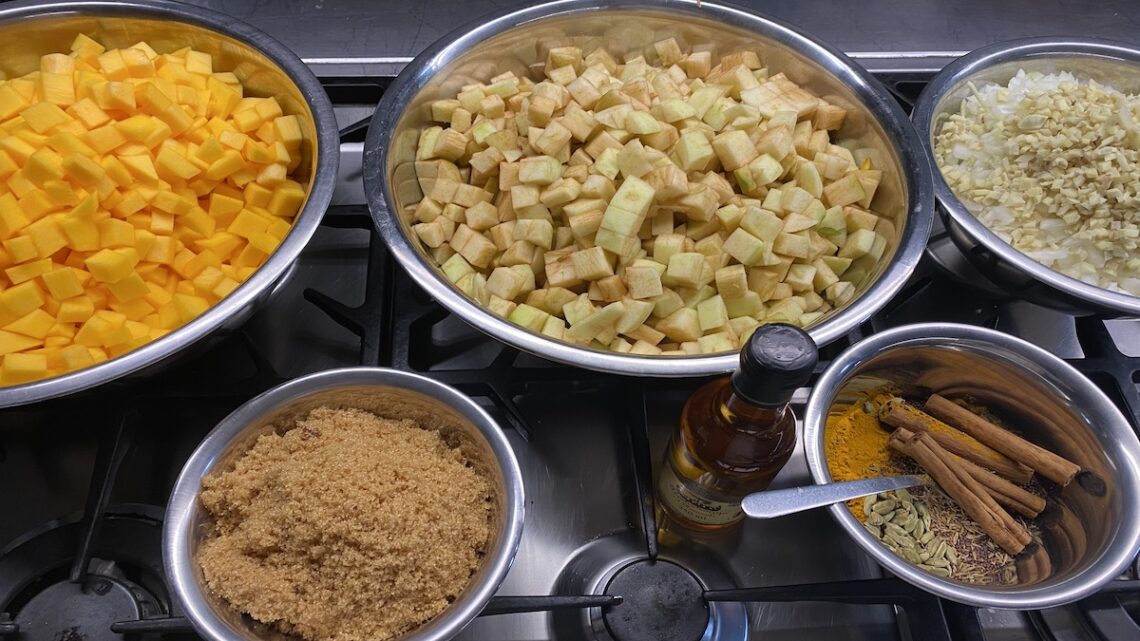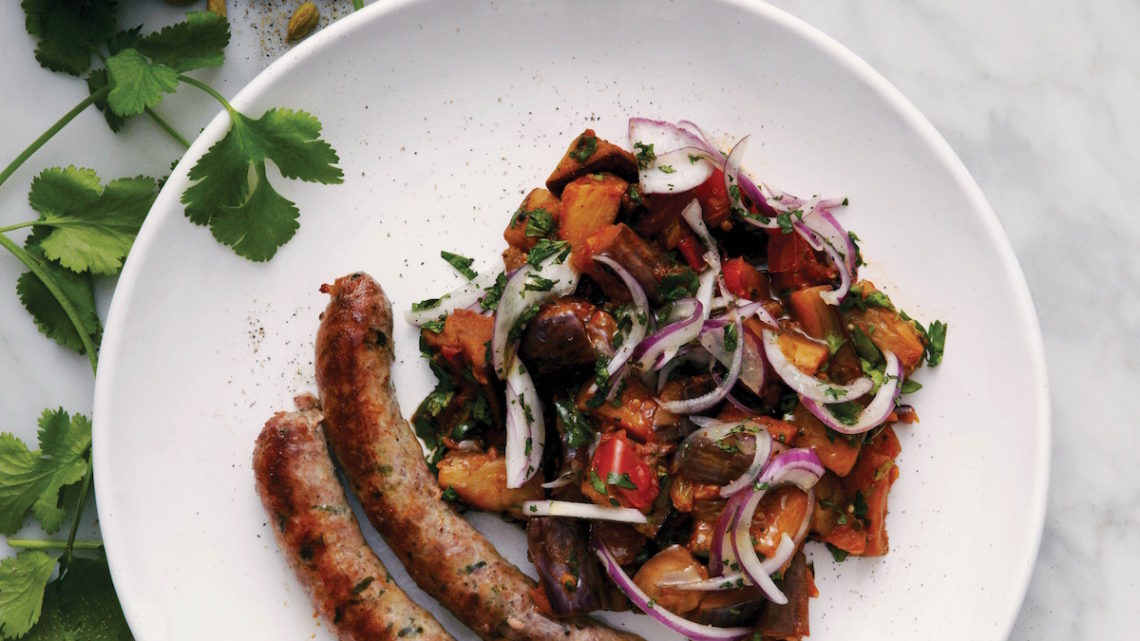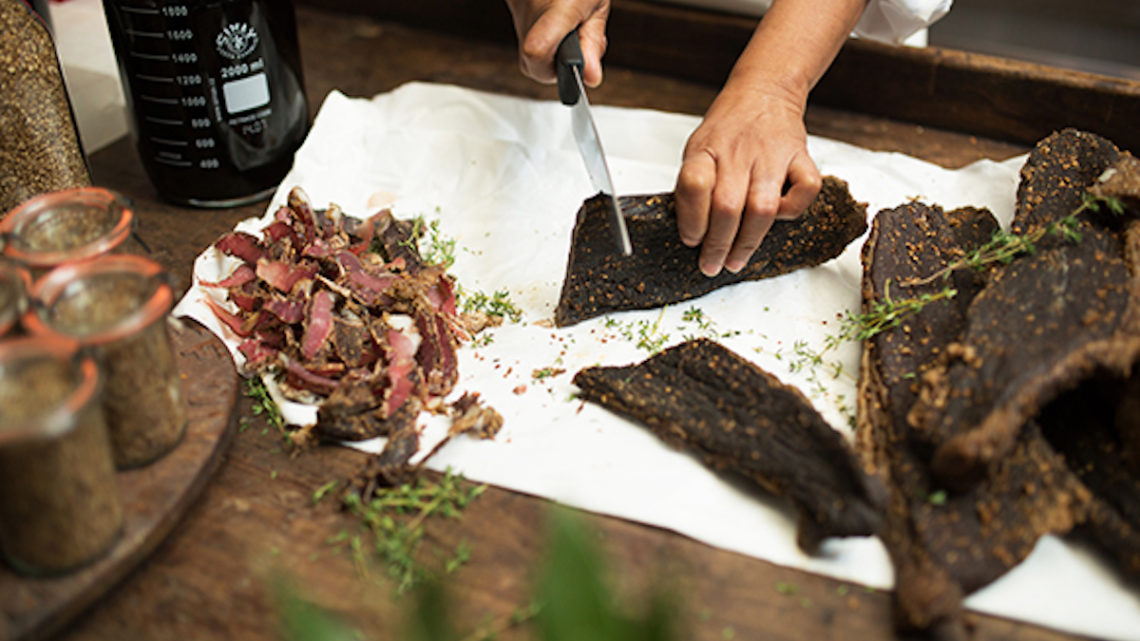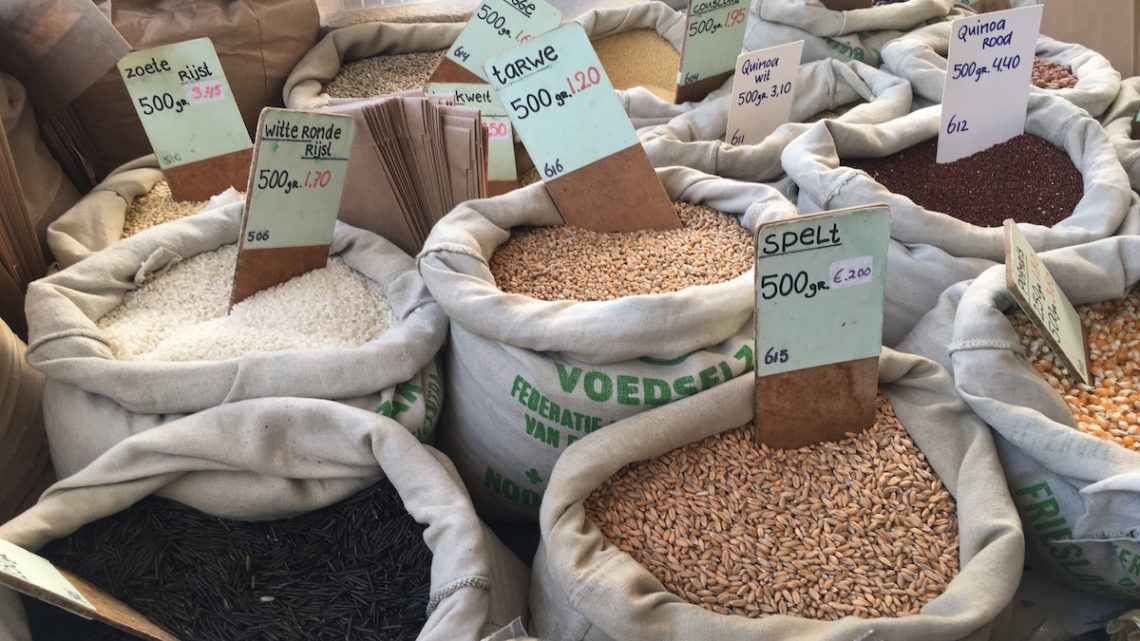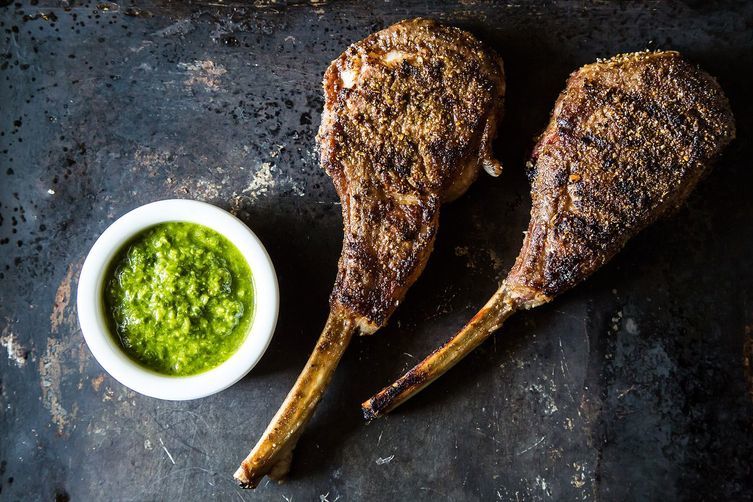Spicy Sausage Stew
A steaming hot pan of this sausage stew set in the middle of the table is the perfect excuse we need for spending a cold evening at home.
Serves 4
Ingredients
1 onion
2 cloves garlic
1 stick celery
1 yellow pepper
1 red pepper
4 spicy sausages of 120-150g each
1 teaspoon smoked paprika
1/2 teaspoon ground cumin
a sprinkle of chilli flakes
2 tins tomato cubes
2 tins cannellini beans
125g baby spinach
25g panko
4 tablespoons olive oil
salt and pepper
Method
Finely chop the onion, garlic and celery. Remove the seeds from the pepper and cut into strips. Drain the liquid off from cannellini beans.
Heat a cast-iron pan over medium-high heat with 3 tablespoons olive oil and fry the sausages until golden brown. Remove from the pan and add the onion and celery. Fry for 5 minutes, then add the rest of cut vegetables and fry for a further 5 minutes.
Add the spices to the pan and fry for 1 minute. Then add the tomatoes, salt and pepper and bring to the boil. Lower the heat to a simmer and cook gently, covered with a lid, for about 10 minutes. Add the sausages and cook for a further 10 minutes. Lastly, add the beans and cook for 5 minutes more.
Heat the grill in an oven. Add the spinach to the pan and mix gently together. Sprinkle over the panko and drizzle over 1 tablespoon olive oil. Place under the grill for 2-3 minutes.
Serve the dish straight from the pan.
Nederlands
voor 4 personen
Ingrediënten
1 ui
2 teentjes knoflook
1 stengel bleekselderij
1 gele paprika
1 rode paprika
4 st pittige worstjes van 120-150gr per stuk
1 theelepel gerookte paprikapoeder
½ theelepel komijnpoeder
snufje chilivlokken
2 blikken tomaatblokjes
2 blikken canellinibonen
125gr baby spinazie
25gr panko
4 eetlepels olijfolie
zout en peper
Bereiding
Snijd ui, knoflook en bleekselderij fijn. Verwijder de zaadjes van de paprika’s en snijd in reepjes. Giet het vocht van de bonen af.
Verwarm een gietijzer pan op medium-hoog vuur met 3 eetlepels olijfolie en bak de worstjes rondom goudbruin. Haal ze uit de pan en voeg de ui en selderij toe. Bak 5 minuten, voeg de rest van de gesneden groenten toe en stoof nog 5 minuten.
Voeg de specerijen toe aan de pan en bak 1 minuut. Voeg de tomaten, zout en peper toe en breng aan de kook. Kook zachtjes afgedekt voor ongeveer 10 minuten, voeg de worstjes toe en kook 10 minuten. Voeg de bonen toe en kook nogmaals zachtjes 5 minuten.
Verwarm de grill in de oven. Voeg de spinazie toe en meng voorzichtig door elkaar. Bestrooi met de panko en druppel 1 eetlepel olijfolie eroverheen. Zet 2-3 minuten onder de grill.
Serveer het gerecht direct uit de pan.
Celeriac and Chestnut Soup
A big bowl of warm soup is often the most simplest of pleasures. This time of year lends itself to such soups. We're inspired by the vegetables and flavours that are in season now. Celeriac and chestnuts are a marriage made in heaven.
Serves 2
Ingredients
1 onion
1 clove garlic
2 sticks celery
1kg celeriac
250g vacuum packed chestnuts
1 bay leaf
2 sprigs thyme
1 organic vegetable stock cube
125ml cream
30g panko breadcrumbs
4 tablespoons olive oil, plus extra to finish the dish
2 cloves
2 juniper berries
salt and pepper
Method
Finely chop the onion and garlic. Peel the celeriac and cut into 2 cm cubes. Finely chop the celery and cut the chestnuts in half. Dissolve the stock cube in 1 litre hot water.
Heat a pot over a medium heat with 2 tablespoons olive oil. Add the onion and celery and fry for 1 minute. Add the celeriac to the pot and fry, stirring regularly, for 5 minutes. Add the chestnuts, bay leaf, thyme sprigs, cloves and stock. Bring to the boil, turn down the heat and simmer for about 15-20 minutes until the celeriac is soft.
Remove the thyme sprigs and bay leaf from the pot. Blend to a thick soup with a stick blender. Season with salt and pepper and stir the cream through the soup. Heat a frying pan over medium heat with 2 tablespoons olive oil. Add the panko and fry until golden brown. Transfer the panko to a small bowl and set aside.
Divide the soup between 2 bowls. Sprinkle with the fried panko and drizzle with a few drops of olive oil.
Nederlands
voor 2 personen
Ingrediënten
1 ui
1 teentje knoflook
2 stengels bleekselderij
1kg knolselderij
250gr vacuüm zakje kastanjes
1 laurierblad
2 takjes tijm
1 biologisch groenten bouillonblokje
125 slagroom
30gr panko
4 eetlepels olijfolie, en extra voor het afmaken
2 kruidnagels
2 jeneverbessen
zout en peper
Bereiding
Snijd de ui en knoflook fijn. Schil de knolselderij en snijd in blokjes van 2 cm. Snijd de bleekselderij in dunne plakjes. Snijd de kastanjes in tweeën. Los het bouillonblokje op in 1 liter warm water.
Verwarm een pan op medium vuur met 2 eetlepels olijfolie. Voeg de ui en bleekselderij toe aan de pan en smoor 5 minuten. Voeg de knoflook toe en bak nog eens 1 minuut. Voeg de knolselderij toe aan de pan en bak, al roerend, nog eens 5 minuten. Voeg de kastanjes, laurierblad, tijmblaadjes, kruidnagel, jeneverbessen en bouillon toe. Breng aan de kook en laat 15-20 minuten zachtjes koken tot de knolselderij zacht is.
Verwijder het laurierblad en de tijm. Pureer tot een dikke soep met een staafmixer. Breng op smaak met zout en peper en roer de slagroom er doorheen. Verwarm een koekenpan op medium vuur met 2 eetlepels olijfolie. Voeg de panko toe en bak goudbruin. Haal de panko uit de pan en zet opzij in een kommetje.
Verdeel de soep over 2 kommen. Bestrooi met de gebakken panko (broodkruim) en besprenkel met een paar druppels olijfolie.
Pumpkin & apple chutney
If you happen to be passing a farm store, pumpkins and apples are fully available. Make this delicious apple and pumpkin chutney to enjoy through the winter with curries, cold cuts and cheese.
Ingredients
4 tablespoons sunflower oil
2 onions, peeled and finely chopped
100g ginger, peeled and sliced into thin strips
1 red chilli, deseeded and finely chopped
15 cardamom pods, smashed open
2 cinnamon sticks
1 tablespoon black mustard seeds
2 teaspoons cumin seeds
5 cloves garlic, peeled and finely chopped
1 kg pumpkin, peeled and cut into small cubes
500g Bramley apples, peeled and cut into small cubes
1 teaspoon ground turmeric
500g light brown sugar
300ml cider vinegar
Method
Heat the oil in a large pan, then gently fry the onions until soft. Add the garlic, ginger, chilli, cardamom, cinnamon, mustard and cumin seeds and turmeric and fry together for 5 minutes.
Add the pumpkin and apples to the pan. Cook for 10-15 minutes until the ingredients are softened.
Stir in the sugar and let it melt around the vegetables. Simmer for 5 minutes.
Pour in the vinegar, season with 2 teaspoons salt and bring to a simmer. Cook, stirring regularly for about 30 minutes or until the apple has cooked down and the pumpkin pieces are tender. There should be a little syrupiness in the pan.
Spoon into sterilised jars and seal. They chutney can be eaten straight away or left to mature in a dark place. Store for up to six months.
Cooking workshops
Our cooking workshops are tailored to make you want to cook at home, inspire you and introduce you to new ingredients.
All the ingredients are easily obtainable from good supermarkets and food stores. The recipes which you cook and enjoy during the workshop will be sent to you after the event so that you can recreate them at home to impress your friends and family.
We start with a minimum of 8 people and all our cooking workshops follow RIVM guidelines regarding hygiene and social distancing.
So come with a group of family, friends or colleagues for an unforgettable evening. Book your cooking workshop now!
Merguez Sausages with North African Aubergine
North African cuisine is typified by the use of spices and herbs. This dish is fragrant, spicy, fruity and above all, easy to prepare. It's worth spending a little extra money on good quality sausages. Find a good local butcher who makes there own.
English
Serves 2
Ingredients
4 merguez sausages
1 large eggplant
1/2 teaspoon ground cumin and ½ teaspoon ground cardamon
1 clove garlic
2 tomatoes
10g harissa
25g sultanas
1 small red onion
1 small bunch each coriander and mint
6 tablespoons olive oil
1 tablespoon tomato ketchup
salt and pepper
Method
Finely slice the red onion into half rings. Place them in a bowl. Finely chop the mint, add to the onion with some salt and pepper and set aside. Cut the eggplant into 2 cm cubes. Finely chop the garlic clove. Chop the tomatoes into small cubes.
Heat a frying pan over medium heat with 2 tablespoons olive oil and fry the sausages for about 12-15 minutes until golden brown and cooked through.
Heat a second frying pan with 4 tablespoons olive oil. Add the eggplant to the pan and fry for 3-4 minutes until golden. Add the spice mix and garlic and fry for a further 1 minute. Add the tomatoes, harissa (to taste), tomato ketchup and sultanas to the pan. Cook gently for about 10 minutes. Season with salt and pepper.
Finely chop the coriander and stir through the eggplant. Divide the eggplant between 2 plates. Serve with the sausages and the onion relish.
Nederlands
voor 2 personen
Ingrediënten
4 merguez worstjes
1 grote aubergine
1/2 theelepel gemalen komijn en ½ theelepel gemalen kardemom
1 teentje knoflook
2 pruimtomaten
10g harissa
25g gele rozijnen
1 kleine rode ui
1 bosje koriander en munt
6 eetlepels olijfolie
1 eetlepel tomatenketchup
zout en peper
Bereiding
Snijd de rode ui in dunne ringen. Doe ze in een kom. Snijd de munt fijn en voeg toe aan de ui samen met wat zout en peper. Zet opzij. Snijd de aubergine in blokjes van 2 cm. Hak het knoflook teentje fijn. Snijd de tomaten in kleine blokjes.
Verhit een koekenpan op medium vuur met 2 eetlepels olijfolie en bak de worstjes rondom goudbruin in 12-15 minuten.
Verwarm een tweede koekenpan op medium vuur met 4 eetlepels olijfolie. Voeg de aubergine toe en bak voor 3-4 minuten goudbruin. Voeg het specerijenmengsel en knoflook toe en bak nog eens 1 minuut. Voeg de tomaten, harissa (naar smaak), tomatenketchup en rozijnen toe. Laat zachtjes 10 minuten stoven. Breng op smaak met zout en peper.
Hak de koriander fijn, meng het door de aubergine. Verdeel de aubergine over 2 borden. Leg de worstjes er naast en serveer met de uienrelish.
Biltong
Biltong is a form of dried, cured meat that originated in Southern African countries (South Africa, Zimbabwe and Zambia). Various types of meat are used to produce it, ranging from beef and game meats to fillets of meat cut into strips following the grain of the muscle, or flat pieces sliced across the grain. It is related to beef jerky in that they are both spiced, dried meats; however, the typical ingredients, taste and production processes may differ.
The word biltong is from the Dutch bil ("buttock”") and tong ("strip" or "tongue").
Meat preservation as a survival technique dates back to ancient times. Indigenous peoples of Southern Africa, such as the Khoikhoi, preserved meat by slicing it into strips, curing it with salt, and hanging it up to dry. European seafarers preserved meat for their long journeys by curing meat in salt or brine. European settlers (Dutch, German, French) who arrived in southern Africa in the early 17th century used vinegar in the curing process, as well as saltpetre (potassium nitrate). The potassium nitrate in saltpeter kills Clostridium botulinum, the deadly bacterium that causes botulism while the acidity of the vinegar inhibits its growth. According to the World Health Organization, C. botulinum will not grow in acidic conditions (pH less than 4.6), therefore the toxin will not be formed in acidic foods. The antimicrobial properties of certain spices have also been drawn upon since ancient times. The spices introduced to biltong by the Dutch include pepper, coriander, and cloves.
The need for food preservation in South Africa was pressing. Building up herds of livestock took a long time, but with game in abundance in South Africa, traditional methods were called upon to preserve the meat of large African animals such as the eland in a warm climate. Iceboxes and refrigerators had not been invented yet. Biltong as it is today evolved from the dried meat carried by the wagon-travelling Voortrekkers, who needed stocks of durable food as they migrated from the Cape Colony north and north-eastward (away from British rule) into the interior of Southern Africa during the Great Trek. The meat was preserved and hung to be dried for a fortnight during the colder winter, with the cold temperatures aiding to further inhibit bacterial and fungal growth. Once suitably dried, the biltong was ready for packing in cloth bags, which allow air circulation to prevent mould.
While biltong is usually eaten as a snack, it can also be diced up into stews, or added to muffins or pot bread. Biltong-flavoured potato crisps have also been produced, and there are cheese spreads with biltong flavour. Finely shredded biltong is eaten on slices of bread and in sandwiches.
Biltong can be used as a teething aid for babies.
Biltong is a high-protein food.
Chicken Tikka Masala
Chicken Tikka Masala
Serves 4
Ingredients
sunflower oil
2 large onions, peeled and sliced
1 red or green chili pepper
5 cm piece of fresh ginger, peeled
2 cloves of garlic, peeled
1/2 teaspoon of chili powder
1 teaspoon turmeric
2 teaspoons garam masala
1 tablespoon of brown sugar
1 small can of tomato puree
2 tins of peeled tomatoes
1 kg chicken thighs, cut into cubes
10 curry leaves (optional)
4-6 tablespoons yogurt
Bunch of fresh coriander, finely chopped
Steamed rice, Naan bread and poppadums, to serve
Method
Slice the onion. Heat 2 tablespoons of sunflower oil in a pan. Add the onions and fry on a medium heat for a good 15-20 minutes until they are soft and caramelized. In the meantime finely chop the chilli ginger and garlic. Add to the onion and fry for 2 more minutes.
Add the chilli powder, turmeric, garam masala and sugar to the onions and fry 1-2 minutes. Add the tomato paste and fry for another 1-2 minutes. Add the tomatoes and allow to simmer for about 10 minutes. Place the sauce in a bowl and blend with a stick blender until smooth.
Add 1 tablespoon of sunflower oil to the same pan and fry the pieces of chicken until they are lightly coloured, about 5 minutes. Pour the sauce and curry leaves, if you using them and some salt and cook gently, cover for about 20 minutes until the chicken is cooked and tender.
Stir the yogurt and half the chopped coriander through the tikka masala. Garnish with the remaining coriander and serve with steamed rice, Naan bread and / or poppadums.
Fresh Herbs and Spices and the Noordemarkt
Saturday's are one of our favourite days of the week. After a slow start, there is nothing better than to wonder the small streets of the Jordaan and head over to the bustling Noordemarkt.
We've spoken before about the array of ingredients on offer. But, with the cold wintery weather, we are going to get some fresh herbs to make a big batch of soul-warming chicken soup and the best harissa you will ever taste!
There are beautiful bundels of soup herbs that you can buy to add to your pan of steaming goodness. They also make the most amazing table decorations if you're hosting a dinner. Another thing we're also going to be getting, which you don't see too often and will be the prefect addition to our soup is lovage (maggi in Dutch). It comes in herb and root form and is similar in flavour to celery. We'll put some of the leaves and the peeled root into the soup, but the root is also perfect grated into salads.
So if you're going to do groceries today, maybe add a few of these items to your list. Wishing you all a delicious weekend. Happy eating!
Kumar's Cooking Event
Kumar's Curries and Bumbu's recently hosted the launch of their new product range at Amsterdam Flavours. Watch the after video here.
Lamb Racks with Chimichurri
Serves 6
Ingredients
50 ml soy sauce
50 ml sunflower oil
3 tablespoons sherry
4 garlic cloves, minced
2 racks lamb chops, french trimmed
4 tablespoons cumin seeds, toasted
2 tablespoons Szechuan peppercorns, toasted
2 tablespoons salt
1 tablespoon coriander seeds, toasted
1/4 teaspoon red chili flakes (optional)
Coriander Chimichurri
1 cup coriander leaves
1 garlic clove, finely chopped
1 pinch red pepper flakes
1/2 lime, juiced
2 tablespoons fresh jalapeño or green chilli, chopped
2 tablespoons rice vinegar
80 ml olive oil
Method
Begin with the coriander chimichurri. Blend all ingredients without the oil. Then drizzle in oil with the machine running. Season to taste with salt.
Mix soy sauce, oil, sherry, and garlic together. Cut lamb into 6 equal pieces and marinate for 6 to 8 hours. Grind cumin seeds, peppercorns, and coriander seeds. Mix with salt and chili and sprinkle liberally over lamb. Heat a grill pan over medium heat and grill until rose inside. Let rest about 5 minutes, then slice each piece in half. Serve with the coriander chimichurri.
We, the Amsterdam Flavours chefs, hope you enjoy this recipe as much as we do. If you have any questions on how to prepare it or just want to send us your feedback, you can reach us here Contact Amsterdam Flavours


